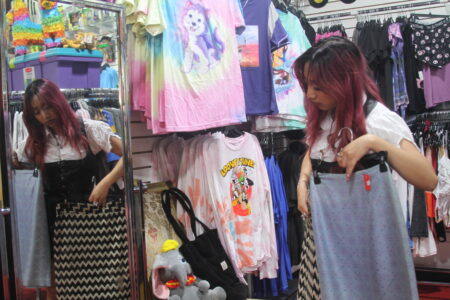
Have you ever looked into your closet to find your most loved clothing piece, but then realize that you no longer fit into it? You either pass it down to your family members, donate it or sell it. Reselling clothes has become a popular side hustle that many take part in to get some extra cash. A generation of new entrepreneurs is hoping shoppers like to buy thrifted clothes through social media.
Social media apps offer a space where you can promote your clothing line or make your own business. It is now more accessible to make a profit from selling clothes. Youtubers like Isabella McFadden, known as internetgirl, and Alli Vera sell thrifted outfit bundles ranging from $100-300. They’re not just selling the clothes; they are styling outfits for people at a cost that’s lower than a boutique or department store. Buyers can leave notes on what kind of clothes they feel comfortable wearing, and sellers work to create a curated collection of clothing items just for them.
These curators began to inspire younger audiences to thrift more and taught them how to properly style the pieces. More YouTube videos promoting the usage of thrifting started surfacing and the common title “Thrift with Me” became trendy.
The reselling community has grown more since the pandemic started, and many small social media accounts run by younger women began to join in on the business. On Instagram, you can find a countless number of accounts in a location or neighborhood near you. The best quality pieces or stylish clothing that you could only find in your local thrift stores before are now sold online, but critics are worried this could affect the environment and the shopability of thrift stores for low-income shoppers.
Maidely Cuervo is a reseller with over 1k followers on Instagram with the name @delliim1. She has received hateful comments stating that the resellers are “stealing from the poor” under her social media post promoting her resells. While Cuervo does buy clothes from thrift stores to resell, she is still leaving high amounts of good quality clothes for other shoppers to purchase. Cuervo goes out of her way to research timeless styles so she is sure to only resell clothes that are best for her online audience. She is able to properly thrift without taking potential clothes from others in her neighborhood.

Most local resale accounts do not support the idea of wasting clothes. Diana Pulido, another reseller through Instagram known as @angel1cthrift, expresses her feelings on helping the Earth when she thrifts for her items in Goodwill bins. Pulido prefers to shop through the Goodwill bins rather than purchasing through traditional thrift stores since it is more sustainable and offers more affordable prices.
Pulido dedicates her time looking through countless bins in the Goodwill outlets rather than shopping through thrift stores. The reseller shares that her reasoning on why she chooses to shop the bins is because it’s the last stop for thrifted goods before they are dumped in a landfill or textile recycling places.
Upcycling is another way curators like to sell their thrifted items. Thrift store accounts on social media are purchasing items that they can make more appealing to their customers by sewing or changing the look of the item.
“I’ve been getting into upcycling, which is transforming a shirt into a dress or putting your style to it,” says Pulido.
This gives a new life to a simple t-shirt that most likely won’t be sold. Cuervo mentions how upcycling can be as simple as cropping and hemming a T-shirt. Not only does this make the clothing piece more buyable, but it makes for a positive environmental business ethic.
In the business aspect, selling better quality second hand clothing can be beneficial since thrifting is a cheaper option when compared to shopping for brand new clothes. Younger shoppers get to create their own looks without breaking the bank. Fabian Pateno, who works at Thriftyland in Anaheim, mentions how resellers can be seen as personal shoppers and he advocates for their hustle.
“That reseller has to spend their time and gas to go find the pieces. They list it and answer questions about everything they are selling, then have to package and ship it,” says Pateno. “The resellers went off, put the effort in and you can consider them like a personal shopper in a way.”
Shopping for branded clothing can be a privilege. For low-income families, it is common to shop at thrift stores and cheaper clothing stores. It is a more affordable option and although it’s secondhand there are many options to choose from while thrifting. The question comes into mind if small thrifting accounts are causing thrift stores to raise their prices or taking away potential clothing from lower-income shoppers who depend on thrift stores.

As thrifting became popular among younger audiences, there have been more people shopping through the racks. More sales were being made at thrift stores, wealthier teens began to overspend and purchase immense amounts of clothing while shopping at these thrift stores. On TikTok, small curators go to thrift stores and fill up their carts with clothes. Although thrifting is an environmentally friendly practice, overconsumption of clothes that won’t be used could be taking clothing away from someone less fortunate who would wear them or cause thrift stores to raise prices because of its popularity.
“ I feel like thrift stores are going to have skyrocketing prices because it is now being gentrified,” says Pulido.
Betizada, a mother that purchases clothes from thrift stores for herself and her family, doesn’t feel the same frustration about reselling as critics do. “I guess I have mixed feelings. There are aspects of these people who are taking their time and going on to look for the clothing that kind of takes away from the stores. For me it’s nostalgic to come and thrift. I’m 50/50,” says Betizada.
Betizada expresses that while shopping with her three kids at Thriftyland, she acknowledges the prices going up, but that it isn’t something that she considers to be an issue or has stopped her from thrifting. The shopper had been thrifting throughout her life and continues to do so now that she has her own children. Collecting spongebob t-shirts and thrifted toys is a way she keeps her kids content.
The issue that critics have against resellers based on the idea that they are stealing thrifted goods from low-income households, may not be as negative of an impact to the shoppers. Thrift shops and local thrifters notice the rise in prices, but aren’t as upset as the media makes it out to be. Overall, thrift stores continue to be essential for low income families to attain affordable clothing and beneficial for resellers who are looking to make some extra money.


